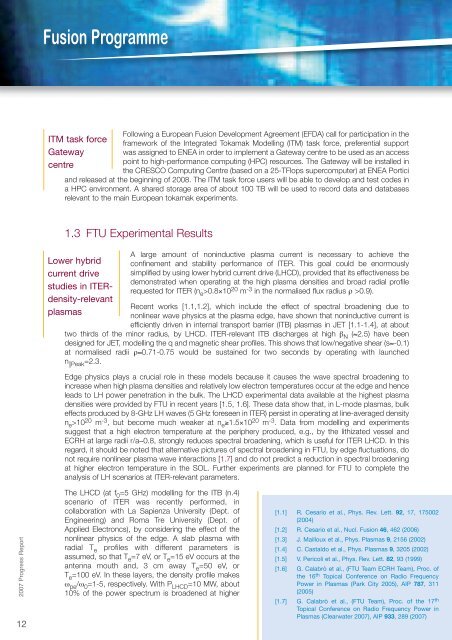Fusion Programme - ENEA - Fusione
Fusion Programme - ENEA - Fusione
Fusion Programme - ENEA - Fusione
- No tags were found...
Create successful ePaper yourself
Turn your PDF publications into a flip-book with our unique Google optimized e-Paper software.
<strong>Fusion</strong> <strong>Programme</strong>Following a European <strong>Fusion</strong> Development Agreement (EFDA) call for participation in theITM task force framework of the Integrated Tokamak Modelling (ITM) task force, preferential supportGatewaywas assigned to <strong>ENEA</strong> in order to implement a Gateway centre to be used as an accesspoint to high-performance computing (HPC) resources. The Gateway will be installed incentrethe CRESCO Computing Centre (based on a 25-TFlops supercomputer) at <strong>ENEA</strong> Porticiand released at the beginning of 2008. The ITM task force users will be able to develop and test codes ina HPC environment. A shared storage area of about 100 TB will be used to record data and databasesrelevant to the main European tokamak experiments.1.3 FTU Experimental ResultsLower hybridcurrent drivestudies in ITERdensity-relevantplasmasA large amount of noninductive plasma current is necessary to achieve theconfinement and stability performance of ITER. This goal could be enormouslysimplified by using lower hybrid current drive (LHCD), provided that its effectiveness bedemonstrated when operating at the high plasma densities and broad radial profilerequested for ITER (n e >0.8×10 20 m -3 in the normalised flux radius ρ >0.9).Recent works [1.1,1.2], which include the effect of spectral broadening due tononlinear wave physics at the plasma edge, have shown that noninductive current isefficiently driven in internal transport barrier (ITB) plasmas in JET [1.1-1.4], at abouttwo thirds of the minor radius, by LHCD. ITER-relevant ITB discharges at high β N (≈2.5) have beendesigned for JET, modelling the q and magnetic shear profiles. This shows that low/negative shear (s≈-0.1)at normalised radii ρ≈0.71-0.75 would be sustained for two seconds by operating with launchedn ||Peak =2.3.Edge physics plays a crucial role in these models because it causes the wave spectral broadening toincrease when high plasma densities and relatively low electron temperatures occur at the edge and henceleads to LH power penetration in the bulk. The LHCD experimental data available at the highest plasmadensities were provided by FTU in recent years [1.5, 1.6]. These data show that, in L-mode plasmas, bulkeffects produced by 8-GHz LH waves (5 GHz foreseen in ITER) persist in operating at line-averaged densityn e >10 20 m -3 , but become much weaker at n e ≥1.5×10 20 m -3 . Data from modelling and experimentssuggest that a high electron temperature at the periphery produced, e.g., by the lithizated vessel andECRH at large radii r/a∼0.8, strongly reduces spectral broadening, which is useful for ITER LHCD. In thisregard, it should be noted that alternative pictures of spectral broadening in FTU, by edge fluctuations, donot require nonlinear plasma wave interactions [1.7] and do not predict a reduction in spectral broadeningat higher electron temperature in the SOL. Further experiments are planned for FTU to complete theanalysis of LH scenarios at ITER-relevant parameters.2007 Progress Report12The LHCD (at f 0 =5 GHz) modelling for the ITB (n.4)scenario of ITER was recently performed, incollaboration with La Sapienza University (Dept. ofEngineering) and Roma Tre University (Dept. ofApplied Electroncs), by considering the effect of thenonlinear physics of the edge. A slab plasma withradial T e profiles with different parameters isassumed, so that T e =7 eV, or T e =15 eV occurs at theantenna mouth and, 3 cm away T e =50 eV, orT e =100 eV. In these layers, the density profile makesω pe /ω 0 =1-5, respectively. With P LHCD =10 MW, about10% of the power spectrum is broadened at higher[1.1] R. Cesario et al., Phys. Rev. Lett. 92, 17, 175002(2004)[1.2] R. Cesario et al., Nucl. <strong>Fusion</strong> 46, 462 (2006)[1.3] J. Mailloux et al., Phys. Plasmas 9, 2156 (2002)[1.4] C. Castaldo et al., Phys. Plasmas 9, 3205 (2002)[1.5] V. Pericoli et al., Phys. Rev. Lett. 82, 93 (1999)[1.6] G. Calabrò et al., (FTU Team ECRH Team), Proc. ofthe 16 th Topical Conference on Radio FrequencyPower in Plasmas (Park City 2005), AIP 787, 311(2005)[1.7] G. Calabrò et al., (FTU Team), Proc. of the 17 thTopical Conference on Radio Frequency Power inPlasmas (Clearwater 2007), AIP 933, 289 (2007)













